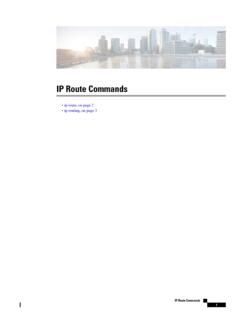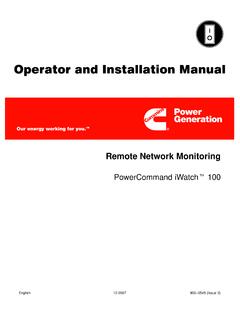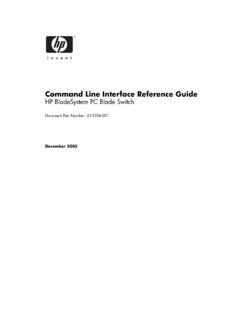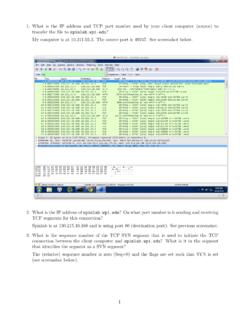Transcription of TCP/IP Illustrated TCP/IP Illustrated, Volume 1
1 TCP/IP Illustrated TCP/IP Illustrated , Volume 1. The Protocols W. Richard Stevens Contents Preface Chapter 1. Introduction Introduction Layering TCP/IP Layering Internet Addresses The Domain Name System Encapsulation Demultiplexing Client-Server Model Port Numbers Standardization Process RFCs Standard, Simple Services The Internet Implementations Application Programming Interfaces Test Network Summary Chapter 2. Link Layer Introduction Ethernet and IEEE 802 Encapsulation Trailer Encapsulation file:///D|/Documents%20and%20 Settings/bigini/Documenti/homenet2run/tc pip/tcp-ip- (1 of 9) [12/09/2001 ]. TCP/IP Illustrated SLIP: Serial Line IP. Compressed SLIP. PPP: Point-to-Point Protocol Loopback Interface MTU. Path MTU. Serial Line Throughput Calculations Summary Chapter 3. IP: Internet Protocol Introduction IP Header IP Routing Subnet Addressing Subnet Mask Special Case IP Address A Subnet Example ifconfig command netstat command IP Futures Summary Chapter 4.
2 ARP: Address Resolution Protocol Introduction An Example ARP Cache ARP Packet Format ARP Examples Proxy ARP. Gratuitous ARP. arp command Summary Chapter 5. RARP: Reverse Address Resolution Protocol Introduction RARP Packet Format RARP Examples RARP Server design Summary file:///D|/Documents%20and%20 Settings/bigini/Documenti/homenet2run/tc pip/tcp-ip- (2 of 9) [12/09/2001 ]. TCP/IP Illustrated Chapter 6. ICMP: Internet Control Message Protocol Introduction ICMP Message Types ICMP Address Mask Request and Reply ICMP Timestamp Request and Reply ICMP Port Unreachable Error Processing of ICMP Messages Summary Chapter 7. Ping Program Introduction Ping Program IP Record Route Option IP Timestamp Option Summary Chapter 8. Traceroute Program Introduction Traceroute Program operation LAN output WAN output IP Source Routing Option Summary Chapter 9. IP Routing Introduction Routing Principles ICMP Host and Network Unreachable Errors To Forward or Not to Forward ICMP Redirect Errors ICMP Router Discovery Messages Summary Chapter 10.
3 Dynamic Routing Protocols Introduction Dynamic Routing Unix Routing Daemons file:///D|/Documents%20and%20 Settings/bigini/Documenti/homenet2run/tc pip/tcp-ip- (3 of 9) [12/09/2001 ]. TCP/IP Illustrated RIP: Routing Information Protocol RIP Version 2. OSPF: Open Shortest Path First BGP: Border Gateway Protocol CIDR: Classless Interdomain Routing Summary Chapter 11. UDP: User Datagram Protocol Introduction UDP Header UDP Checksum A Simple Example IP Fragmentation ICMP Unreachable Error (Fragmentation Required). Determining the Path MTU Using Traceroute Path MTU Discovery with UDP. Interaction Between UDP and ARP. Maximum UDP Datagram Size ICMP Source Quench Error UDP Server Design Summary Chapter 12. Broadcasting and Multicasting Introduction Broadcasting Broadcasting Examples Multicasting Summary Chapter 13. IGMP: Internet Group Management Protocol Introduction IGMP Message IGMP Protocol An Example Summary Chapter 14. DNS: The Domain Name System Introduction DNS Basics file:///D|/Documents%20and%20 Settings/bigini/Documenti/homenet2run/tc pip/tcp-ip- (4 of 9) [12/09/2001 ].
4 TCP/IP Illustrated DNS Message Format A Simple Example Pointer Quiries Resourse Records Caching UDP or TCP. Another Example Summary Chapter 15. TFTP: Trivial File Transfer Protocol Introduction Protocol An Example Security Summary Chapter 16. BOOTP: Bootstrap Protocol Introduction BOOTP Packet Format An Example BOOTP Server Design BOOTP Through a Router Vendor-Specific Information Summary Chapter 17. TCP: Transmission Control Protocol Introduction TCP Services TCP Header Summary Chapter 18. TCP Connection Establishment and Termination Introduction Connection Establishment and Termination Timeout of Connection Establishment Maximum Segment Size TCP Half-Close TCP State Transition Diagram Reset Segments file:///D|/Documents%20and%20 Settings/bigini/Documenti/homenet2run/tc pip/tcp-ip- (5 of 9) [12/09/2001 ]. TCP/IP Illustrated Simultaneous Open Simultaneous Close TCP Options TCP Server Design Summary Chapter 19. TCP Interactive Data Flow Introduction Interactive Input Delayed Acknoledgements Nagle Algorithm Windows Size Advertisments Summary Chapter 20.
5 TCP Bulk Data Flow Introduction Normal Data Flow Sliding Windows Window Size PUSH Flag Slow Start Bulk Data Throughput Urgent Mode Summary Chapter 21. TCP Timeout and Retransmission Introduction Simple Timeout and Retransmission Example Round-Trip Time Measurement An RTT Example Congestion Example Congestion Avoidance Algorithm Fast Retransmit and Fast Recovery Algorithm Congestion Example (Continued). Per-Route Metrics ICMP Errors Repacketization Summary file:///D|/Documents%20and%20 Settings/bigini/Documenti/homenet2run/tc pip/tcp-ip- (6 of 9) [12/09/2001 ]. TCP/IP Illustrated Chapter 22. TCP Persist Timer Introduction An Example Silly Windows Syndrome Summary Chapter 23. TCP Keepalive Timer Introduction Description Keepalive Examples Summary Chapter 24. TCP Futures and Performance Introduction Path MTU Discovery Long Fat Pipes Windows Scale Option Timestamp Option PAWS: Protection Against Wrapped Sequence Numbers T/TCP: A TCP Extension for Transactions TCP Performance Summary Chapter 25.
6 SNMP: Simple Network Management Protocol Introduction Protocol Structure of Management Information Object Identifiers Introduction to the Management Information Base Instance Identification Simple Examples Management Information Base (Continued). Additional Examples Traps and BER. SNMP Version 2. Summary file:///D|/Documents%20and%20 Settings/bigini/Documenti/homenet2run/tc pip/tcp-ip- (7 of 9) [12/09/2001 ]. TCP/IP Illustrated Chapter 26. Telnet and Rlogin: Remote Login Introduction Rlogin Protocol Rlogin Examples Telnet Protocol Telnet Examples Summary Chapter 27. FTP: File Transfer Protocol Introduction FTP Protocol FTP Examples Summary Chapter 28. SMTP: Simple Mail Transfer Protocol Introduction SMTP Protocol SMTP Examples SMTP Futures Summary Chapter 29. NFS: Network File System Introduction Sun Remote Procedure Call XDR: External Data Representation Port Mapper NFS Protocol NFS Examples NFS Version 3. Summary Chapter 30.
7 Other TCP/IP Applications Introduction Finger Protocol Whois Protocol Archie, WAIS, Gopher, Veronica and WWW. X Window System Summary file:///D|/Documents%20and%20 Settings/bigini/Documenti/homenet2run/tc pip/tcp-ip- (8 of 9) [12/09/2001 ]. TCP/IP Illustrated Appendix A. The tcpdump Program BSD Packet Filter SunOS Network Interface Tap SVR4 Data Link Provider Interface tcpdump Output Security Considerations Socket Debug Option Appendix B. Computer Clocks Appendix C. The sock Program Appendix D. Solutions to Selected Exercises Appendix E. Configurable Options BSD/386 version SunOS System V Release 4. Solaris AIX Appendix F. Source Code Availability Acronyms You can write to the designer of this page. All critics are welcome. file:///D|/Documents%20and%20 Settings/bigini/Documenti/homenet2run/tc pip/tcp-ip- (9 of 9) [12/09/2001 ]. Preface Preface Introduction This book describes the TCP/IP protocol suite, but from a different perspective than other texts on TCP/IP .
8 Instead of just describing the protocols and what they do, we'll use a popular diagnostic tool to watch the protocols in action. Seeing how the protocols operate in varying circumstances provides a greater understanding of how they work and why certain design decisions were made. It also provides a look into the implementation of the protocols, without having to wade through thousands of lines of source code. When networking protocols were being developed in the 1960s through the 1980s, expensive, dedicated hardware was required to see the packets going "across the wire.". Extreme familiarity with the protocols was also required to comprehend the packets displayed by the hardware. Functionality of the hardware analyzers was limited to that built in by the hardware designers. Today this has changed dramatically with the ability of the ubiquitous workstation to monitor a local area network [Mogul 1990]. Just attach a workstation to your network, run some publicly available software (described in Appendix A), and watch what goes by on the wire.
9 While many people consider this a tool to be used for diagnosing network problems, it is also a powerful tool for understanding how the network protocols operate, which is the goal of this book. This book is intended for anyone wishing to understand how the TCP/IP protocols operate: programmers writing network applications, system administrators responsible for maintaining computer systems and networks utilizing TCP/IP , and users who deal with TCP/IP applications on a daily basis. Organization of the Book The following figure shows the various protocols and applications that are covered. The italic number by each box indicates the chapter in which that protocol or application is described. file:///D|/Documents%20and%20 Settings/ (1 of 6) [12/09/2001 ]. Preface (Numerous fine points are missing from this figure that will be discussed in the appropriate chapter. For example, both the DNS and RPC use TCP, which we don't show.)
10 We take a bottom-up approach to the TCP/IP protocol suite. After providing a basic introduction to TCP/IP in Chapter 1, we will start at the link layer in Chapter 2 and work our way up the protocol stack. This provides the required background for later chapters for readers who aren't familiar with TCP/IP or networking in general. This book also uses a functional approach instead of following a strict bottom-to-top order. For example, Chapter 3 describes the IP layer and the IP header. But there are numerous fields in the IP header that are best described in the context of an application that uses or is affected by a particular field. Fragmentation, for example, is best understood in terms of UDP (Chapter 11), the protocol often affected by it. The time-to-live field is fully described when we look at the Traceroute program in Chapter 8, because this field is the basis for the operation of the program. Similarly, many features of ICMP are described in the later chapters, in terms of how a particular ICMP message is used by a protocol or an application.







